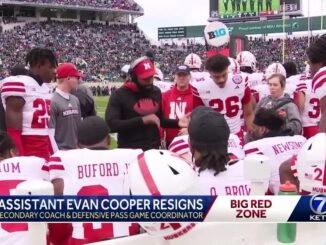Devastating Wildfires Threaten Nebraska Stadium: A Call for Action.
In a shocking turn of events, wildfires have ignited in the Midwest, threatening not only the natural landscape but also significant landmarks, including the iconic Nebraska stadium. The fires have spread rapidly due to a combination of dry conditions, high winds, and record temperatures, forcing communities to grapple with both immediate and long-term consequences.
#### The Causes of the Wildfires
The wildfires currently ravaging parts of Nebraska and neighboring states can be traced to several interrelated factors:
1. **Climate Change**: Increasing global temperatures have resulted in prolonged periods of drought across the Midwest. This has dried out vegetation, creating a perfect environment for wildfires to flourish.
2. **Weather Conditions**: The region has been experiencing unusually high temperatures and strong winds, which exacerbate fire conditions. These weather patterns have made it easier for fires to ignite and spread rapidly.
3. **Human Activity**: Land management practices, such as failure to properly clear underbrush and debris, have contributed to the intensity of these wildfires. Additionally, the role of human activity in igniting these fires—whether through negligence or accidents—cannot be overlooked.
#### The Impact on Nebraska Stadium
The Nebraska stadium, known for its rich history and fervent fan base, is more than just a sports venue; it’s a cultural landmark. The ongoing fires pose a significant threat to this beloved site:
– **Physical Damage**: If the fires spread to the stadium, the physical infrastructure could be severely damaged, disrupting not only sporting events but also community gatherings and concerts.
– **Economic Consequences**: The stadium serves as an economic engine for the region. A significant disruption could affect local businesses that rely on game days for revenue. Hotels, restaurants, and retail shops could see a substantial decline in income.
– **Community Spirit**: The stadium is a gathering place that fosters community spirit. Any damage to it could dampen morale and lead to a sense of loss among residents who take pride in their local team and its home.
#### Immediate Responses and Evacuations
In response to the escalating threat, local authorities have taken immediate action:
– **Evacuations**: Residents in high-risk areas have been ordered to evacuate. Emergency shelters are being set up to provide a safe haven for those displaced by the fires.
– **Firefighting Efforts**: Firefighters from various regions have mobilized to combat the flames. Resources are being allocated to contain the fires and protect critical infrastructure, including the stadium.
– **Community Support**: Local organizations and volunteers have stepped up to provide assistance, offering food, shelter, and emotional support to those affected by the fires.
#### Long-Term Solutions
While immediate responses are crucial, addressing the root causes of these wildfires requires a comprehensive approach:
1. **Improved Land Management**: Implementing better land management practices, such as controlled burns and regular maintenance of forested areas, can help mitigate future wildfire risks.
2. **Cross-State Collaboration**: Since wildfires often affect multiple states, collaboration between local, state, and federal agencies is vital. Sharing resources and strategies can enhance firefighting capabilities.
3. **Public Education**: Raising awareness about wildfire risks and prevention measures is essential. Communities need to be educated on how to prepare for wildfires, including creating defensible spaces around properties.
4. **Climate Change Mitigation**: Long-term strategies to address climate change are imperative. Investing in renewable energy, reducing carbon emissions, and promoting sustainable practices can help combat the environmental conditions that lead to wildfires.
#### Conclusion
The wildfires threatening Nebraska stadium are a stark reminder of the growing risks posed by climate change and inadequate land management practices. As communities in the Midwest rally to protect their homes and landmarks, it is essential to adopt a holistic approach to fire prevention and community resilience. By working together and implementing sustainable practices, we can hope to safeguard not just the Nebraska stadium but also the spirit of the communities it represents.
As we face this challenging moment, it is a call to action for all of us to come together, support one another, and prioritize the protection of our environment and shared heritage.



Be the first to comment